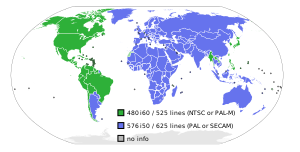This article needs additional citations for verification. (May 2023) |

625-line (or CCIR 625/50) is a late 1940s European analog standard-definition television resolution standard.[1][2] It consists of a 625-line raster, with 576 lines carrying the visible image at 25 interlaced frames per second. It was eventually adopted by countries using 50 Hz utility frequency as regular TV broadcasts resumed after World War II.[3] With the introduction of color television in the 1960s,[4] it became associated with the PAL and SECAM analog color systems.
A similar 525-line system was adopted by countries using 60 Hz utility frequency (like the US). Other systems, like 375-line, 405-line, 441-line, 455-line and 819-line existed, but became outdated or had limited adoption.
The modern standard-definition digital video resolution 576i is equivalent and can be used to digitize an analogue 625-line TV signal, or to generate a 625-line compatible analog signal.[5]
- ^ Observer, Reflective (December 23, 2021). "Where did 625-line TV come from?".
- ^ "Televisionen - Das Fernsehen in der UdSSR / TV in the USSR Die Geschichte des Fernsehens in Russland". www.scheida.at.
- ^ "Piet's Home-built Television". Maximus R&D.
- ^ "Television broadcasting 1960-70: BBC 625-line services and the introduction of colour" (PDF).
- ^ "What means 576i?". Afterdawn.com.
© MMXXIII Rich X Search. We shall prevail. All rights reserved. Rich X Search
